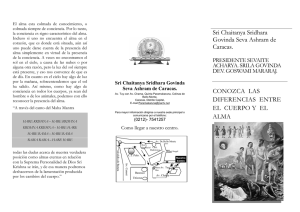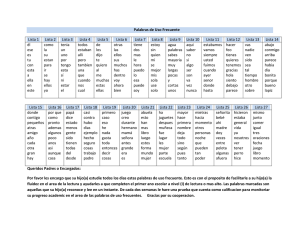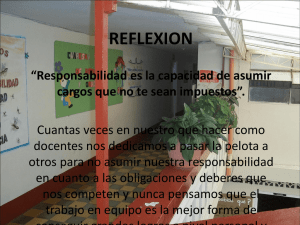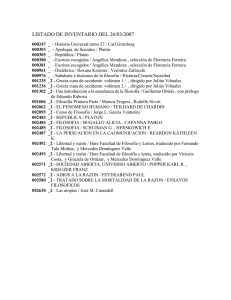Por qué Algo Ahí?, texto de Mario Montalbetti
Anuncio
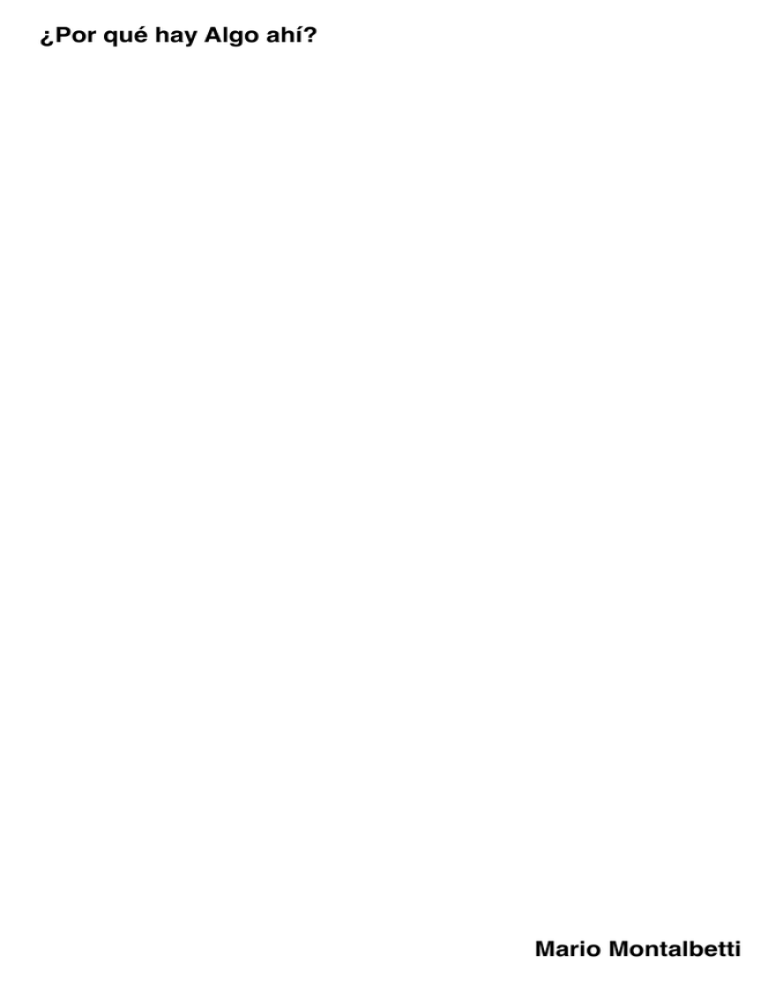
¿Por qué hay Algo ahí? Mario Montalbetti ¿Por qué hay Algo ahí? Lo primero que se me ocurre como respuesta a la pregunta del título es la frase de Beckett que Billy Hare ha incluido en su serie de fotografías: “sólo en tu cabeza”. Hay algo ahí, pero a la vez no hay nada ahí; más bien, hay algo en tu cabeza. La idea es semejante a la del famoso comentario de Hui Neng que aparece en el Caso 29 del Mumonkan: “no es la bandera ni el viento lo que flamea sino tu mente”. El problema es que estos días la mente tiene maneras más bien decepcionantes de flamear. No sólo le cuesta distinguir viento de bandera sino que concede con facilidad que la realidad pueda ser una procesión infinita de simulacros. Eso ya no es flamear sino una forma de regresión a la infancia. Hemos perdido, entre otras cosas, la capacidad de distinguir lugares: ahí se ha vuelto cualquier lugar y ya no tiene consistencia geológica ni topográfica, es meramente virtual. Frente a ello, las fotografías de Hare son comentarios insistentes a la noción de lugar, a la noción de algo ahí—y a sus particiones. Why is there Something there? My first thought in answer to the title’s question is the Beckett phrase Billy Hare includes in his photography series: “all in the mind”. There’s something there, but at the same time there’s nothing there; there is, rather, something in the mind. The idea is similar to Hui Neng’s famous commentary to Case 29 in the Mumonkan: “not the flag, not the wind; mind is moving.” The trouble is that nowadays the mind moves in rather disappointing ways. Not only does it find it difficult to distinguish wind from flag; it easily concedes that reality may be an infinite procession of simulacra. This is not the mind flapping but a regression to childhood. We have lost, among other things, our ability to distinguish between places; there has become anywhere and no longer has a geographic or topographic consistence; it is merely virtual. Given this, Hare’s photographs are insistent commentaries on the notion of place, on the notion of something there – and on its partitions. Hare has been doing this for a long time. He acknowledges that the place is split, is divided, and that in this parting and dividing an order Tarma, Junín 1981 Tarma, Junín 1981 Hare ha venido haciendo esto desde hace tiempo. Reconoce que el lugar se parte, se divide, y que en sus particiones y divisiones impone un orden. Su monumental retrospectiva de 1997 lo mostró con claridad. Y si queremos encontrar un antecedente directo al trabajo actual basta con ir a la p. 119 del catálogo de dicha muestra (a la serie Tarma 1981) como evidencia. El cuerpo, el desierto, la huaca, las mesas, la calle, la piedra… que aparecen en las imágenes de Hare son particiones del lugar. Todos son casos de ahí entendido como el incesante movimiento de división entre ahí y no-ahí. ¿Dónde? Si uno pregunta uno (se) pierde. Porque la primera paradoja es que tanto lo que hay como lo que no hay está, o no está, ahí. Como Beckett en El Innombrable (“no lo sé, nunca lo sabré, debes seguir, no puedo seguir, seguiré”), Hare no puede seguir pero sigue—fotografiando. Y es porque Hare fotografía hasta que ya no puede seguir que puede seguir. Y lo que sigue es seguir fotografiando hay algo aquí. Esto debe entenderse correctamente: Hare no fotografía el algo que hay ahí sino el que haya algo ahí. O más bien: Hare fotografía el ahí donde puede haber o no haber algo. En eso es muy distinto del resto de fotógrafos trabajando actualmente que solamente celebran las múltiples y las más superficiales formas de lo que hay. Si bien Hare siempre lo hizo, en esta serie las exigencias son mayores. Barranco, Lima 1981 is imposed. His monumental 1997 retrospective showed this clearly. If we were to look for a direct precursor to the present work we need only refer to p. 119 of the 1997 exhibition catalogue (the series Tarma 1981) as evidence. The body, the desert, the archaeological remains, the tables, the street, the rock in Hare’s images are partitions of place. They are all cases of a there understood as the constant shifting of the division between there and not-there. Where? If one asks one is lost. Because the original paradox is that both what there is and what there is not are, or are not, there. As Beckett in The Unnamable (“I don’t know, I’ll never know [...], you must go on, I can’t go on, I’ll go on”), Hare can’t go on but goes on – taking photographs. And it is because Hare takes photographs until he can’t go on that he can go on. And what goes on is going on taking photographs of something there. This must be correctly understood: Hare doesn’t take the photograph of something that is there but of the fact that there’s something there. Or rather: Hare takes a photograph of the there where there may or may not be something. In this he differs vastly fom the rest of photographers working at present who just celebrate the multiple and most superficial manifestations of what there is. Although Hare has always done it, in this series the stakes are higher. Hay entonces una segunda respuesta posible si cambiamos ligeramente la pregunta de por qué a cómo es que hay Algo ahí. Es decir, ¿cómo es que llegamos a este libro? La insistencia de Billy Hare en seguir es su insistencia en pensar la fotografía. Pero ‘pensar’ es un verbo difícil de usar en fotografía—y en las artes visuales en general—al menos si pensar es articular formas, darles sentido (es decir, dirección) y negarles permanencia enfrentando a unas con otras. Pensar es un acto evanescente, pensar es flamear, ser viento, bandera y mente en sucesión. Pero pensar es también pensar la exclusión, pensar lo que inevitablemente se omite cuando se piensa. Billy Hare hace exactamente eso: arroja cada nueva muestra contra la anterior, tratando de meditar, desde dentro de sus imágenes, qué es lo que ha sido excluido en el proceso. Cuando nos damos cuenta de que ahí es un lugar pero que no-ahí es el mismo lugar, algo ocurre. Cuando nos damos cuenta de que el amor que hay es idéntico al amor que no hay, algo ocurre. O como diría Hare, hay algo ahí. Lo que hay es el terreno sobre el que toda partición es posible. Deleuze escribió que “pensar es confrontar una línea”. ¿Qué línea? Una posibilidad: la línea misma que permite la división entre aquí y no-aquí o entre amor y desamor. Otra es que ante la opción entre el There could, therefore, be another possible answer, if we were to slightly alter the question and ask not why but how there is Something there. That is, how is it that we arrived at this book? Billy Hare’s persistence on going on is his persistence on thinking photography. But ‘to think’ is a difficult verb to apply to photography –and to visual arts in general. At least it is if we define thinking as articulating forms, giving them sense (that is, direction) and denying them permanence by confronting them to each other. Thinking is an evanescent act; to think is to flap, to be successively wind, flag and mind. But to think is also to think on the exclusion, on what is inevitably left out when one thinks. Billy Hare does precisely that: he throws each new exhibition against the previous one, attempting to meditate, from within his images, on what has been left out in the process. Once we realize that there is a place but that not-there is the same place, something happens. Once we realize the love there is is equal to the love there is not, something happens. Or, as Hare would put it, there’s something there. What there is is the space where every partition is possible. Deleuze wrote that “As soon as you begin thinking, you necessarily confront a line”. But what line? A possibility: the line itself VC3888 / 2009 mundo de acá y el mundo de allá (y no importa si allá es al otro lado del río o realmente allá) uno debe elegir ninguno de los dos. Porque cuando se rechazan ambos, cuando tanto el viento como la bandera son dejados de lado, ambos se vuelven mucho más interesantes. Creo que eso es en lo que insiste Hare como forma de su pensamiento fotográfico: hay un lugar anterior a las particiones, hay algo ahí. Y ese lugar es el que Hare trata de capturar con sus imágenes evanescentes. Eso lo puede hacer solamente alguien que no es un artista. Esto puede sonar extraño pero recuerdo que en una entrevista (que no logro ubicar) Hare dijo algo parecido, dijo que “no se consideraba un artista”. Todo el mundo diría sin ninguna duda que Billy Hare es un artista de primer orden—pero Hare no es todo el mundo. Él no ve lo que todo el mundo ve. Hare ve detrás de los hábitos y las costumbres y los reglamentos. No se siente un artista porque no es un hábito más. No se dedica a adornar muros con suplementos técnicos que puedan ser comercializables en el mercado—como lo hace cualquier artista—ni a agregar comentarios visuales a una realidad que es toda ella un comentario visual de sí misma. that allows for the division between here and not-here or between love and unlove. Another possibility is that, faced with the choice between this world and the world beyond (and it is immaterial if beyond means the other shore or really beyond) one must chose neither. Because it is when they are both rejected, when both wind and flag are left behind, that they both become much more interesting. I think this is what Hare insists on, the form his photographic thinking takes: there’s a place previous to the partitions, there’s something there. And that is the place Hare strives to capture in his evanescent images. Serie Nazca la noche NJN 9009 / 2014 This can only be achieved by someone who isn’t an artist. This may sound weird, but I recall Hare said something similar in an interview (that I can’t seem to place); he said he didn’t consider himself an artist. Everybody would say without a doubt that Billy Hare is a first rate artist – but Hare isn’t everybody. He does not see what everybody sees. Hare sees beyond habit and customs and regulations. He doesn’t feel he’s an artist because he isn’t just another habit. He does not devote himself to decorating walls with technical supplements that can be put on sale on the market –as any artist does– nor to add visual commentary to a reality that is an entire visual commentary on itself. Encuentro entonces una tercera respuesta posible a por qué hay Algo ahí. Lo que Hare sigue (“debes seguir, no puedo seguir, seguiré”) no es fotografiando sino un lenguaje que se le escapa como agua entre las manos. Un lenguaje que aparece, desaparece, y que va en una cierta dirección pero a ninguna parte. Que haya algo ahí es sorprendente, sí—pero que lo que hay sea el flujo permanente de un lenguaje lo es mucho más. Y es ese flujo, cuyo eco en nuestras mentes es la admirable figura del flamear, que Hare refleja en su trabajo (casi) como una forma de escritura; imágenes que no se quedan quietas sino que van, que se mueven, detrás de las cosas, hacia ahí, que es un lugar y es ninguna parte. I find, therefore, a third possible answer to why is there Something there. What Hare pursues (“you must go on, I can’t go on, I’ll go on”) is not photography but a language that slips like water between his hands. A language that appears, disappears and goes in a certain direction but does not go anywhere. The fact there is something there is in itself amazing, yes – but the fact that what is there is the permanent flux of a language is even more so. And it is this flux, whose echo in our minds is the admirable figure of flapping, that Hare reflects in his works (almost) as a form of writing; images that don’t keep still but go on, that move, behind things, towards there, which is a place and is nowhere. Serie Nazca la noche NJN 9009 / 2014 Billy Hare (Juan Guillermo Hare), Lima, Perú, 1946. Discípulo de Minor White y Aaron Siskind, entre 1977 y 1978 asiste al programa de Master del Rhode Island School of Design (RISD) en calidad de becario de la Comisión Fulbright. En 1992 es distinguido con la John Simon Guggenheim Foundation Fellowship. Fue miembro fundador de la Asociación Secuencia (1976-1980), como de Secuencia Fotogalería. Asimismo participa en la fundación del Departamento de Fotografía del Instituto Gaudi (1993), del Centro de la Fotografía (1999) y de la fotogalería El Ojo Ajeno (2000). Ha ejercido la docencia en la Pontificia Universidad Católica del Perú (PUCP), la Universidad de Lima y la Universidad de Ciencias Aplicadas (UPC). Como actividad paralela a su trabajo creativo y de enseñanza, Hare ha colaborado en diversos proyectos editoriales en torno al paisaje y las culturas del Perú. En 1997 la Fundación Telefónica del Perú organizo una retrospectiva de su obra, publicando el catalogo “Billy Hare Fotografías“. Su obra forma parte del Museo de Arte de Lima (MALI) y, de colecciones públicas y privadas del Perú y el extranjero. Billy Hare (Juan Guillermo Hare), Lima, Perú, 1946. Disciple of Minor White and Aaron Siskind. Between 1977 and 1978 attends the Rhode Island School of Design’s (RISD) Master programme as a Fulbright Commision scholar. In 1992 he is awarded with the John Simon Guggenheim Foundation Fellowship. He was founder member of Asociación Secuencia (1976-1980) as well as of Secuencia Photogallery. He also takes part in establishing the Department of Photography in Instituto Gaudi(1993), the Centro de la Fotografía (1999) and the photogallery El Ojo Ajeno(2000). He has taught in the Pontificia Universidad Católica del Perú (PUCP), the Universidad de Lima and the Universidad Peruana de Ciencias Aplicadas (UPC). As a parallel activity to his teaching and creative production, Hare has collaborated in various editorial projects about Peruvian landscape and cultures. Fundación Telefónica del Perú organized in 1997 a retrospective exhibit of his work, publishing the catalog “Billy Hare Fotografías“. His photographs form part of the Museo de Arte de Lima (MALI) and other public and private collections in Perú and abroad. *Esta publicación fué realizada con motivo de la edición del libro “Algo Ahí” de Billy Hare. KWY ediciones ISBN: 978-612-46702-3-7 Billy Hare, Fernando La Rosa y Mario Montalbetti, miembros fundadores de Secuencia Foto-Galería (1976-1981) espacio pionero de formación y reflexión dedicado a la fotografía en el Perú. www.kwyediciones.com

